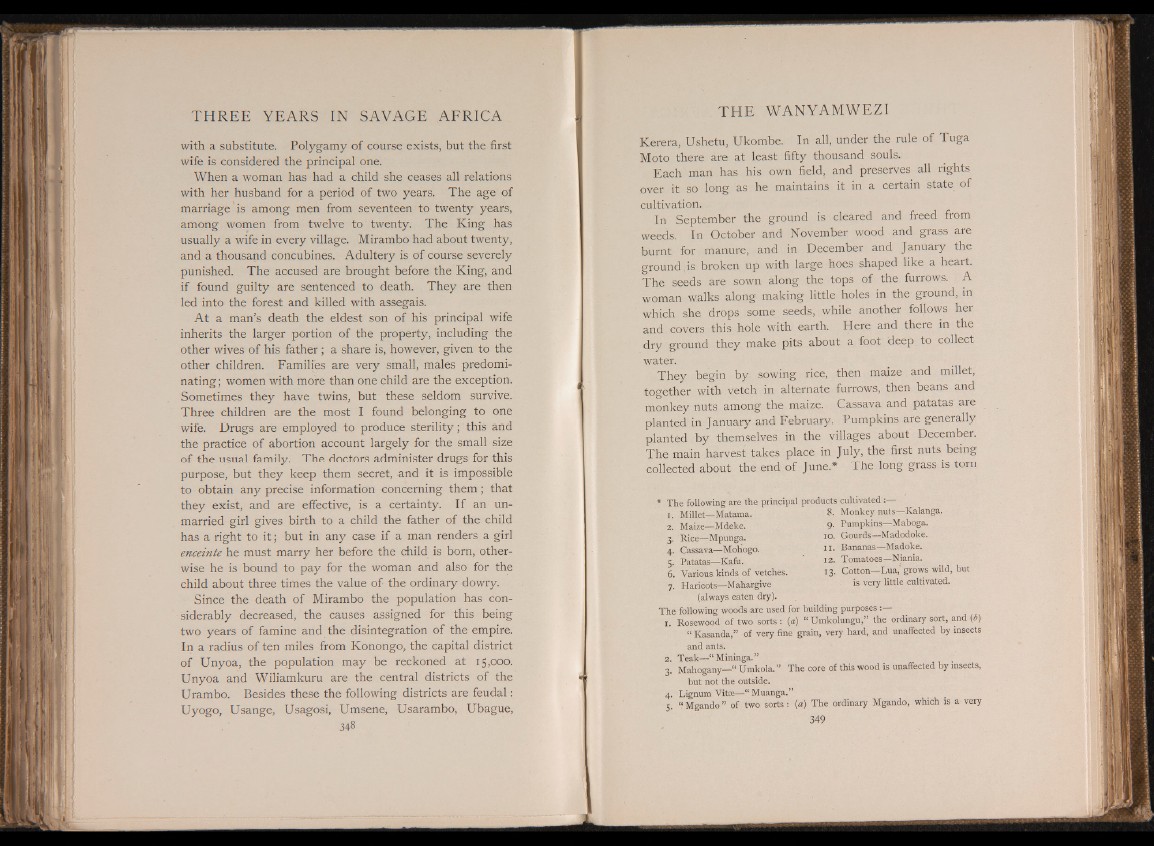
with a substitute. Polygamy of course exists, but the first
wife is considered the principal one.
When a woman has had a child she ceases all relations
with her husband for a period of two years. The age of
marriage is among men from seventeen to twenty years,
among women from twelve to twenty. The King has
usually a wife in every village. Mirambo had about twenty,
and a thousand concubines. Adultery is of course severely
punished. The accused are brought before the King, and
if found guilty are sentenced to death. They are then
led into the forest and killed with assegais.
At a man’s death the eldest son of his principal wife
inherits the larger portion of the property, including the
other wives of his father; a share is, however, given to the
other children. Families are very small, males predominating;
women with more than one child are the exception.
Sometimes they have twins, but these seldom survive.
Three children are the most I found belonging to one
wife. Drugs are employed to produce sterility; this and
the practice of abortion account largely for the small size
of the usual family. The doctors administer drugs for this
purpose, but they keep them secret, and it is impossible
to obtain any precise information concerning them; that
they exist, and are effective, is a certainty. If an unmarried
girl gives birth to a child the father of the child
has a right to it ; but in any case if a man renders a girl
enceinte he must marry her before the child is born, otherwise
he is bound to pay for the woman and also for the
child about three times the value of the ordinary dowry.
Since the death of Mirambo the population has considerably
decreased, the causes assigned for this being
two years of famine and the disintegration of the empire.
In a radius of ten miles from Konongo, the capital district
of Unyoa, the population may be reckoned at 15,000.
Unyoa and Wiliamkuru are the central districts of the
Urambo. Besides these the following districts are feudal:
Uyogo, Usange, Usagosi, Umsene, Usarambo, Ubague,
348
Kerera, Ushetu, Ukombe. In all, under the rule of Tuga
Moto there are at least fifty thousand souls.
Each man has his own field3 and preserves all rights
over it so long as he maintains it in a certain state of
cultivation.
In September the ground is cleared and freed from
weeds. In October and November wood and grass are
burnt for manure, and in December and January the
ground , is broken up with large hoes shaped like a heart.
The seeds are sown along the tops of the furrows. A
woman walks along making little holes in the ground, in
which she drops some seeds, while another follows her
and covers this hole with earth. Here and there in the
dry ground they make pits about a foot deep to collect
water.
They begin by sowing rice, then maize and millet,
together with vetch in alternate furrows, then beans and
monkey nuts among the maize. Cassava and patatas are
planted in January and February. Pumpkins are generally
planted by themselves in the villages about December.
The main harvest takes place in July, the first nuts being
collected about the end of June* The long grass is torn
* The following are the principal products cultivated :—
1. Millet—Matama. 8- Monkey nuts—ICalanga.
2. Maize—Mdeke. 9- Pumpkins—Mahoga.
3. Rice—Mpunga. 10. Gourds—Madodoke.
4. Cassava—Mohogo. n . Bananas—Madoke.
5. Patatas—Kafa. ' 12. Tomatoes—Niania.
6. Various, kinds of vetches. 13. Cotton—Lua, grows wild, but
7. Haricots—Mahargive is very little cultivated.
(always eaten dry).
The following woods are used for building purposes
1. Rosewood of two sorts: (a) “ Umkolungu,” the ordinary sort, and (b)
“ Kasanda,” of very fine grain, very hard, and unaffected by insects
and ants.
2. Teak—“ Mininga.”
3. Mahogany—“ Umkola.” The core of this wood is unaffected by insects,
but not the outside.
4. Lignum Vitse—“ Muanga.”
5. “ Mgando ” of two sorts : (a) The ordinary Mgando, which is a very